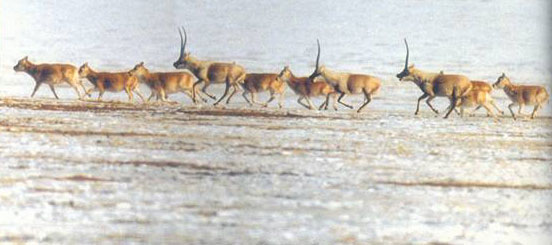- Shivani Thakur
With winters setting in most parts of northern India and designers showcasing their fall collection, it also means bringing out the prized shawls by the rich and the famous. If the Pashminas are considered good buys, the Shahtoosh
are considered to represent class and sophistication. The toosh shawls as they are infamously known, are considered to be an investment worth its weight in gold by many among the well placed. Whereas the Pashminas are easily available in open market, Shahtoosh
are only available on very high discretion because of the ban on their sale.
Pashmina is made from the mountain goat found in the upper Himalayan regions where as Shahtoosh is obtained from the endangered species of the Tibetan antelope found in Tibet . The wool is woven to perfection in Kashmir . The wool
woven is so fine that the whole shawl can pass through a ring finger. Yet the warmth it gives is no match to any other wool. Chiru as the Tibetan antelope is known is found mostly in Tibet with about 10-12 per cent of its population in the Ladakh-Kashmir region.
It is estimated that there are about 75,000 antelopes left in the wild. Wool from five Chiru's is required to make one shawl. The weavers claim that the wool they use is not acquired by slaughtering them but what is usually collected from the bushes where
Chiru roam. But this is not so as around one lakh chiru have died in the past few decades. The wool is often obtained by bartering tiger bones and skin. Thus not only the chiru but we are also ending up losing the tiger and pushing our eco system to collapse.
A drive by Wildlife Department was carried out to declare the shahtoosh shawls so as to stop their illegal trade. In Delhi alone and particularly South Delhi 25,000 shawls were declared. Officials say that more than 200 families
own more than 5 shawls. Each shawl costs about Rs 50,000 in the open market. Brigadier (retired) Ranjeet Talwar of the World Wildlife Fund explains that the main reason for many big addresses of Delhi owning these shawls is to confirm the social standing in
the society. Many a times these shawls are passed from one generation to another. Also, they are gifted to each other to convey their status. In Mumbai too 20,000 shawls have been declared. In July Swiss custom officials had confiscated 537 shawls estimated
to cost about 2.5 million Euros meant for sale in Switzerland , UK , France and the US . Wildlife experts estimate that at least 1,600, more than 3 per cent of the population, could have been slaughtered to produce the seizure.
An act in 1972 under Schedule 1 of Indian Wildlife Act has banned the sale and trade of shahtoosh shawls yet the trade is alive and kicking in Kashmir . Belinda Wright of the Wildlife Protection Society of India remarks that the
wool from Tibet is smuggled into Kashmir where the shawls are made. The finished product then probably reaches Switzerland through China and Korea . She also adds that the trade has seen an upsurge in the past few months and the production of shahtoosh shawls
in Kashmir has increased.
In October 2003 the Government of India made the failure to declare wildlife items a punishable offence. But this has not stopped the production of the shawl as the demand for it is now seen in other parts of the world. To curb this
is a difficult task as now it is not just one endangered species, which is being exploited for wool; We are on the verge of losing the species for ever. Will a hand me down wool shawl satisfy the wanderlust of your grandchild who is willing to travel to the
Himalayan regions to catch a glimpse of the Chiru?

Photograph : Chiru on Tibetan Plateau by Liu Wulin ( IFAW)